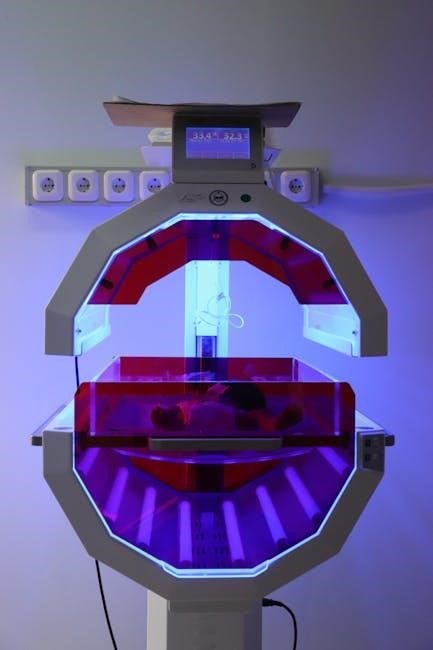Neonatal ventilator settings involve precise management of oxygenation and ventilation to support newborns with respiratory distress, using guidelines and protocols to ensure optimal care and minimize risks, with pdf resources available.
Importance of Ventilator Settings in Neonatal Care
Proper ventilator settings are crucial in neonatal care as they directly impact the newborn’s respiratory function and overall health. The goal of ventilator settings is to provide adequate oxygenation and ventilation while minimizing the risk of lung injury. According to various studies and guidelines, including those available in neonatal ventilator settings pdf, careful management of ventilator settings can significantly improve outcomes for newborns with respiratory distress. This includes reducing the risk of chronic lung disease, improving gas exchange, and promoting optimal lung growth and development. By understanding the importance of ventilator settings, healthcare professionals can provide more effective and targeted care to newborns, ultimately leading to better health outcomes and improved quality of life. Effective ventilator settings also involve careful monitoring and adjustment of parameters such as FiO2, PEEP, and rate to ensure optimal support for the newborn’s unique respiratory needs.

Ventilator Management Guidelines
Guidelines for neonatal ventilator management involve protocols and strategies to optimize care, as outlined in available pdf resources, ensuring effective and safe ventilation practices are followed consistently.
Oxygenation and Ventilation Settings
Oxygenation and ventilation settings are critical components of neonatal ventilator management, requiring careful consideration of factors such as FiO2, PEEP, and tidal volume to ensure optimal gas exchange and minimize lung injury.
The use of pdf resources can provide guidance on establishing appropriate oxygenation and ventilation settings, taking into account the individual needs of each newborn.
Effective management of oxygenation and ventilation is essential to prevent complications such as hypoxia and hypercapnia, and to promote healthy lung development.
By following established guidelines and protocols, healthcare providers can optimize oxygenation and ventilation settings to support the best possible outcomes for newborns requiring ventilatory support.
The development of personalized oxygenation and ventilation strategies is an area of ongoing research, with the goal of improving outcomes and reducing morbidity and mortality in this vulnerable population.
Overall, the careful management of oxygenation and ventilation settings is a critical aspect of neonatal care, and one that requires a deep understanding of the complex physiological needs of newborns.

Understanding PEEP and Its Role in Ventilator Settings
PEEP is a critical component of ventilator settings, using pdf resources to determine optimal levels and improve lung expansion and oxygenation in neonates with respiratory distress.
Typical Starting Settings for Neonatal Ventilation
Typical starting settings for neonatal ventilation involve careful consideration of various parameters, including tidal volume, PEEP, and inspiratory time, as outlined in available pdf resources. The initial settings often include a tidal volume of 5 mL/kg, PEEP of 5 cmH2O, and an inspiratory time dependent on gestational age. For preterm infants, a lower PEEP level may be used, while term infants may require a slightly higher level. The goal is to provide adequate ventilation and oxygenation while minimizing the risk of lung injury. By referring to pdf guidelines, healthcare professionals can determine the most appropriate starting settings for individual patients, taking into account factors such as gestational age, weight, and underlying medical conditions. This ensures that neonates receive optimal ventilatory support, improving their chances of recovery and reducing the risk of complications. Using established pdf protocols helps standardize care and promote best practices in neonatal ventilation.
NAVA Mode of Ventilation and Its Benefits
The NAVA mode of ventilation has gained attention for its potential benefits in neonatal care, as outlined in various pdf resources. This mode of ventilation provides support in proportion to the patient’s neural respiratory drive, allowing for more synchronized and effective breathing. The benefits of NAVA include improved patient-ventilator synchrony, reduced work of breathing, and enhanced lung protection. By using NAVA, healthcare professionals can promote more physiologic breathing patterns, which may lead to better outcomes for neonates. Available pdf guidelines and studies provide valuable insights into the implementation and management of NAVA in neonatal ventilation, helping clinicians to optimize its use and maximize its benefits. The use of NAVA has been shown to be particularly beneficial in certain patient populations, and its incorporation into neonatal ventilator settings can be guided by pdf protocols and recommendations. Overall, NAVA offers a promising approach to neonatal ventilation, with potential advantages over traditional modes of ventilation.

Recommendations for Initial Respiratory Settings
Initial respiratory settings are crucial, with pdf guidelines providing recommendations for optimal neonatal ventilator settings and management strategies to ensure effective care.
Guidelines for Adjusting Ventilator Settings to Prevent VILI
Adjusting ventilator settings is critical to prevent ventilator-induced lung injury (VILI) in neonates, with guidelines recommending careful monitoring of lung mechanics and gas exchange to optimize ventilation strategies.
The use of pdf resources can provide detailed information on adjusting ventilator settings to prevent VILI, including recommendations for tidal volume, peak inspiratory pressure, and positive end-expiratory pressure (PEEP).
Optimal ventilation settings can help minimize lung injury and improve outcomes for neonates requiring mechanical ventilation, and healthcare providers should be familiar with current guidelines and recommendations for adjusting ventilator settings to prevent VILI.
Additionally, the use of volume-targeted ventilation and adaptive pressure ventilation can help reduce the risk of VILI, and should be considered when adjusting ventilator settings for neonates.
Overall, careful adjustment of ventilator settings is essential to prevent VILI and ensure optimal care for neonates requiring mechanical ventilation.
Optimal Ventilation Modes for Neonatal Population
Optimal ventilation modes for the neonatal population involve the use of gentle and supportive strategies to promote lung development and minimize injury.
The choice of ventilation mode depends on the individual needs of the neonate, with options including conventional mechanical ventilation, high-frequency ventilation, and non-invasive ventilation.
A pdf guide to neonatal ventilation can provide detailed information on the optimal ventilation modes for different clinical scenarios, including respiratory distress syndrome and congenital diaphragmatic hernia.
The use of neurally adjusted ventilatory assist (NAVA) and adaptive pressure ventilation can also be beneficial in promoting optimal ventilation and minimizing lung injury.

Healthcare providers should be familiar with the optimal ventilation modes for the neonatal population and be able to select the most appropriate mode for each individual patient.
By using the optimal ventilation mode, healthcare providers can help promote optimal lung development and minimize the risk of lung injury in neonates.